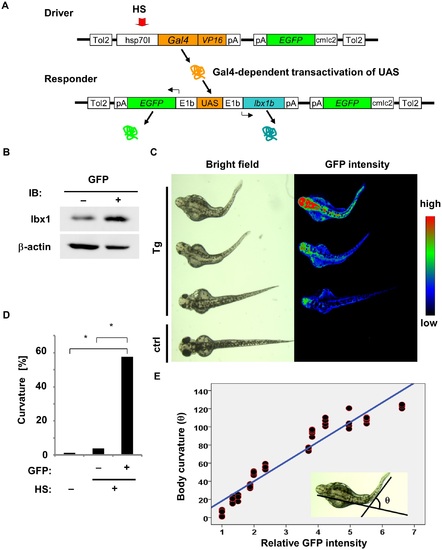Fig. 3
- ID
- ZDB-FIG-160311-17
- Publication
- Guo et al., 2016 - Functional Investigation of a Non-coding Variant Associated with Adolescent Idiopathic Scoliosis in Zebrafish: Elevated Expression of the Ladybird Homeobox Gene Causes Body Axis Deformation
- Other Figures
- All Figure Page
- Back to All Figure Page
|
Body curvature induced by lbx1b overexpression under the control of the heat shock-inducible hsp70I promoter. (A) The constructs in the Gal4/UAS?based bidirectional expression system. The F0 driver transgenic carriers were crossed with the F0 responder transgenic carriers to produce Tg(hsp:Gal-VP;EGFP:UAS:lbx1b) F1. Heat shock (HS) treatment activated the hsp70I promoter in the transgene driver (Driver), which expresses Gal4-VP16. Gal4-VP16 protein bound to UAS on the transgene responder (Responder) and activates the expression of lbx1b and EGFP via E1b minimal promoters. (B) Expression of lbx1 protein in 48 hpf transgenic zebrafish with (GFP+) or without HS (GFP-). (C) Body curvature of transgenic 48 hpf zebrafish that received HS at 4 hpf. The severity of body curvature was correlated with GFP intensity. (D) Incidence of body curvature at 48 hpf in embryos with (HS+EGFP+, n = 85) and without (HS+EGFP-, n = 129) EGFP expression and without HS (n = 79). The incidence of curvature was significantly increased in the HS+EGFP+ embryos (*p < 0.01). (E) lbx1b expression level and body curvature. A linear regression line was obtained between the relative fluorescence intensity of GFP and the severity of body curvature quantified by the angle θ: [θ/degree] = 21.70 × [relative fluorescence intensity]? 3.37, with the slope coefficient different from 0 (p < 0.01). This model accounted for 92.2% of the θ variance. |
| Fish: | |
|---|---|
| Condition: | |
| Observed In: | |
| Stage: | Long-pec |

